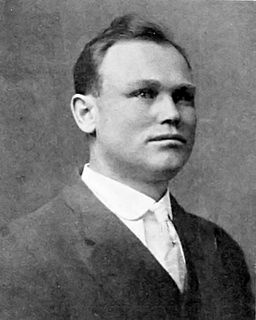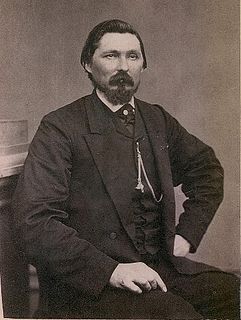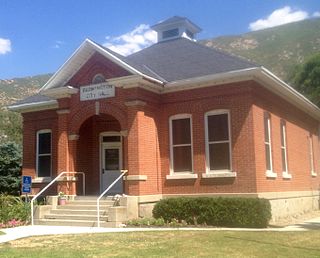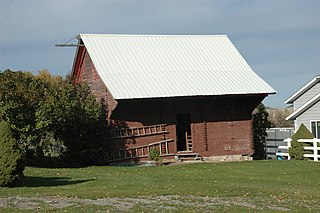
Cache County is a county located in the Wasatch Front region of Utah. As of the 2010 United States Census the population was 112,656. Its county seat and largest city is Logan. Cache County is included in Logan metropolitan area.

Cache Valley is a valley of northern Utah and southeast Idaho, United States, that includes the Logan metropolitan area. The valley was used by 19th century mountain men and was the site of the 1863 Bear River Massacre. The name, Cache Valley is often used synonymously to describe the Logan Metropolitan Area, one of the fastest growing metro areas in the US per capita — both in terms of economic GDP and population.

Hyrum Manwaring, A.B., M.A., was the president of Ricks College in Rexburg, Idaho from 1930 to 1944. Ricks was the precursor to today's Brigham Young University–Idaho, a private university operated by The Church of Jesus Christ of Latter-Day Saints. Manwaring overcame delayed schooling – he was almost 29 when he graduated from high school – to become a dedicated champion of education. He led Ricks through difficult times, when dissolution seemed inevitable, to a point where its future was assured. After retiring from the presidency in 1944, Manwaring continued to teach, and take classes himself, until near his death.

A bishop's storehouse in The Church of Jesus Christ of Latter-day Saints usually refers to a commodity resource center that is used by bishops of the church to provide goods to needy individuals. The storehouses stock basic foods and essential household items. The term can also be used figuratively to refer to all of the time, talents, skills, materials, compassion, and financial means of the members of the church that are available to be applied in the service of the needy.

Teasdale is a census-designated place in western Wayne County, Utah, United States, between the Dixie and Fishlake National Forests and near Capitol Reef National Park. The population was 191 at the 2010 census. Teasdale lies along local roads south of State Route 24, southeast of the town of Loa, the county seat of Wayne County. Although it is unincorporated, Teasdale has a post office, with the ZIP code of 84773.

Cache County School District is a school district located in Cache County, Utah, United States. It serves all the communities within Cache County, except the city of Logan. It is one of 41 school districts within the state and 10th largest in terms of student enrollment.

Abram Chase Hatch was an American Mormon pioneer and missionary and was a politician in Utah Territory.

The Lakeview Tithing Office, also known as the Bunnell Creamery, is a historic building located in Provo, Utah, United States. It is listed on the National Register of Historic Places.
Hyrum Conrad Pope was a German-born architect with important architectural works throughout the western United States and Canada. Pope was born in Fürth, Bavaria and immigrated to the United States as a teenager. He went to school at the Art Institute of Chicago where he was influenced in the Prairie School architectural style. In 1910, he opened an architectural firm with Harold W. Burton in Salt Lake City, Utah. Pope designed a variety of places of worship for many faiths, civic buildings and homes, some of which are listed on the National Register of Historic Places.
Harold William Burton was an early 20th-century architect with architectural works throughout the western United States and Canada. Burton was one of the most prolific architects of chapels, meetinghouses, tabernacles and temples for The Church of Jesus Christ of Latter-day Saints. In 1910 he opened an architectural firm with Hyrum Pope in Salt Lake City, Utah. They particularly appreciated Frank Lloyd Wright and the Prairie School architectural style. As young architects, Pope & Burton won design competitions for two of their better-known works, the Cardston Alberta and Laie Hawaii temples of the LDS Church. Burton moved to Los Angeles, California in 1927 to set up another office in the firm with Pope. After Pope unexpectedly died in 1939, Burton established a new firm with his son Douglas W. Burton. Together they continued to design many buildings, including some for the church, and in 1955 Harold Burton became the chief supervising architect for the LDS Church. One of his final works was the Oakland California Temple. Aside from places of worship, Burton designed civic buildings and homes. Many of his works exist today, some of which are listed on the National Register of Historic Places.
Lorenzo Snow Young, nicknamed "Bing", was a 20th-century architect in Utah. Young practiced for 40 years in Salt Lake City, Utah and is credited with having designed over 700 buildings.

The Lehi Ward Tithing Barn-Centennial Hall, located behind 651 North 200 East in Lehi, Utah, was built in 1872. It was listed on the National Register of Historic Places in 1998.

The Farmington Tithing Office, at 110 N. Main St. in Farmington, Utah, was built during 1907–1909. It was listed on the National Register of Historic Places in 1985.

The Clarkston Tithing Granary, at 10212 N. 8700 West in Clarkston, Utah was built in 1905 to house inkind tithing donations by The Church of Jesus Christ of Latter-day Saints. It was listed on the National Register of Historic Places in 1985.

The Richmond Tithing Office, also known as Bishop's Storehouse, in Richmond, Utah, was built in 1907. It was listed on the National Register of Historic Places in 1985.

Karl C. Schaub was a Swiss-born American architect who designed many buildings in the state of Utah, including the NRHP-listed Hyrum First Ward Meetinghouse and Old Main in Logan. He was the co-partner of Schaub and Monson with Joseph Monson for eight years. He also served as a bishop of The Church of Jesus Christ of Latter-day Saints.

The Fairview Tithing Office/Bishop's Storehouse is a historic building in Fairview, Utah, United States. It was built with red bricks in 1908 as a tithing office and bishop's office for The Church of Jesus Christ of Latter-day Saints. The bishop at the time was James C. Peterson. The building was designed in the Victorian Eclectic architectural style, with a pyramid roof. It was sold to Henry A. Rasmussen, who remodelled it as a private residence, in 1932. It has been listed on the National Register of Historic Places since January 25, 1985.














